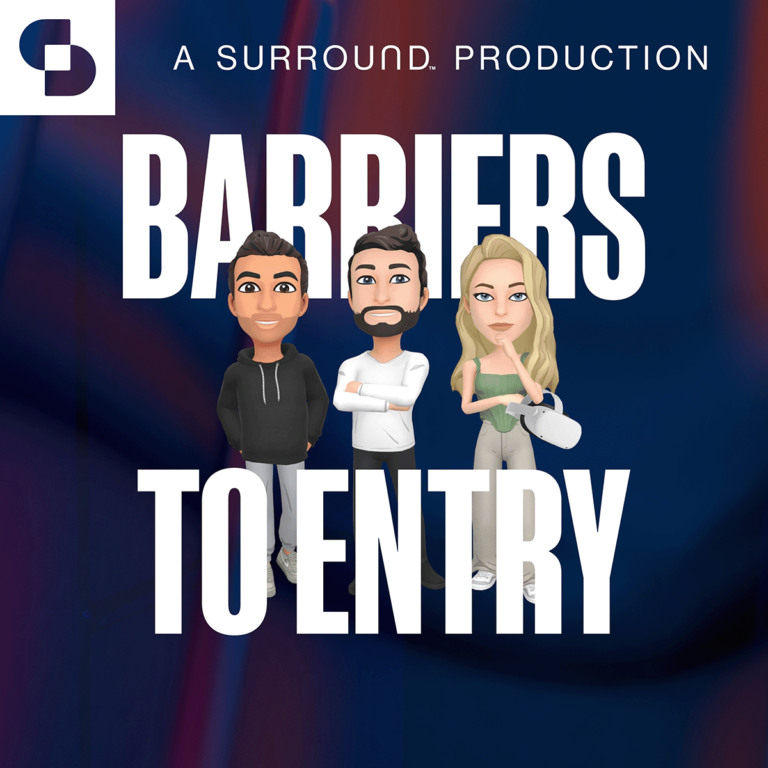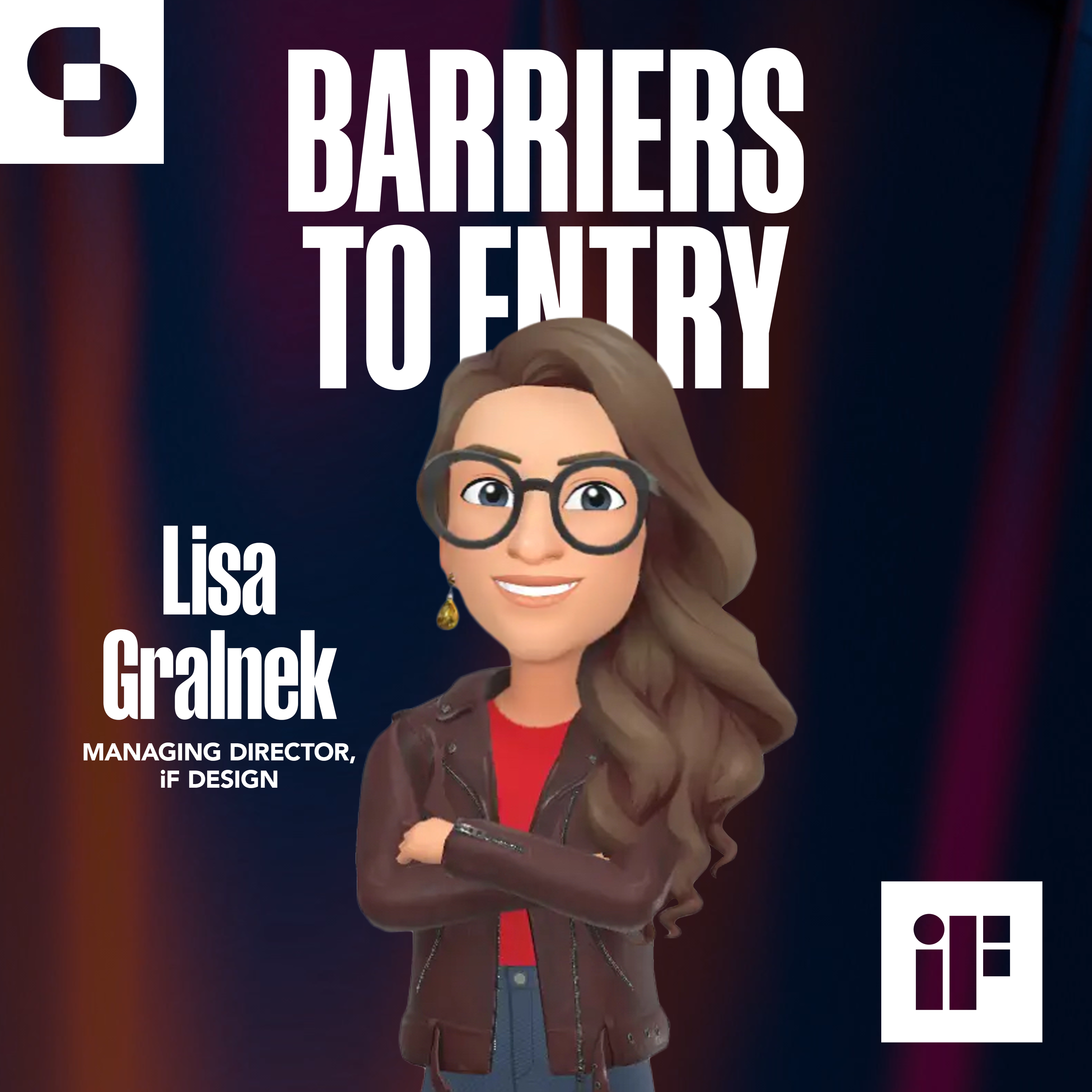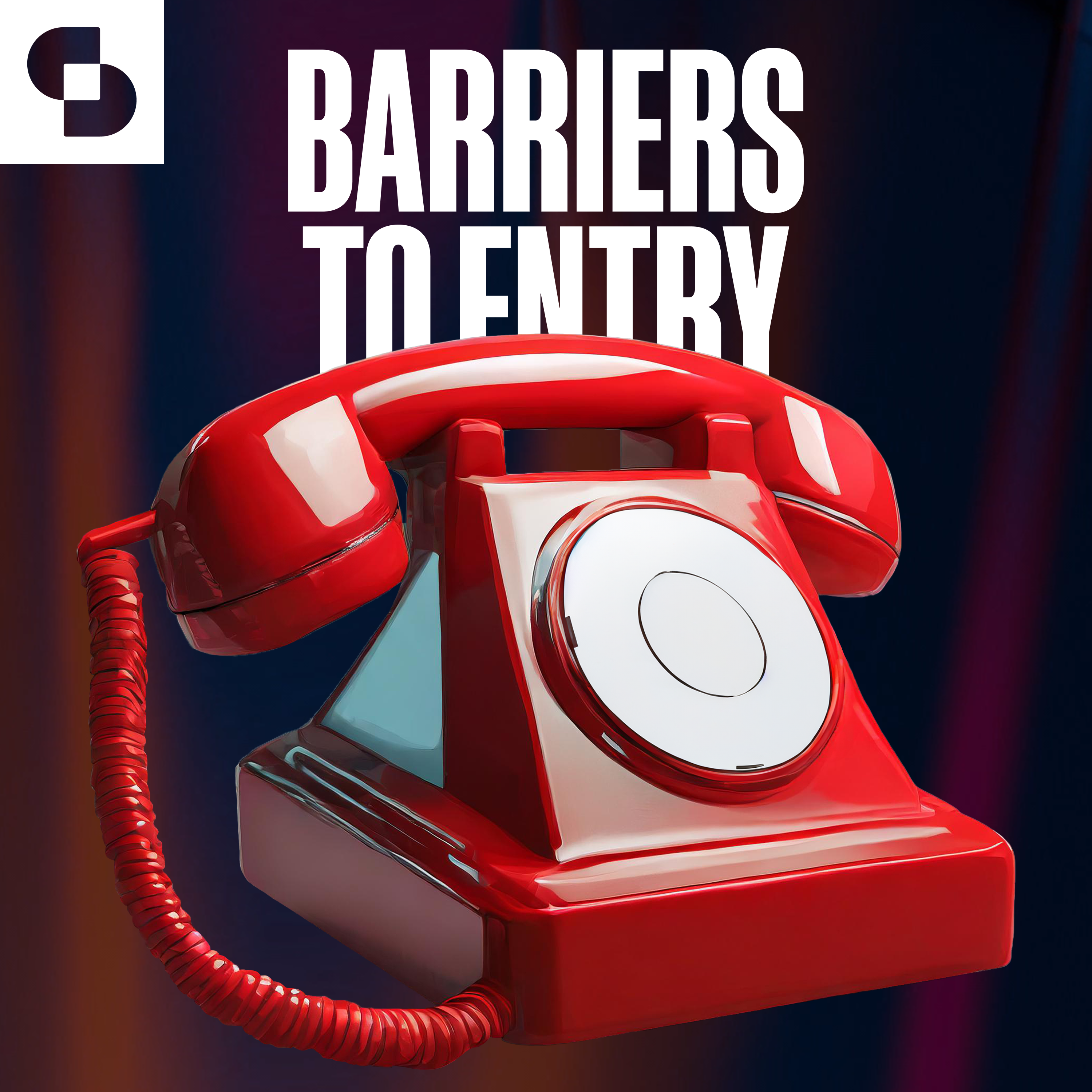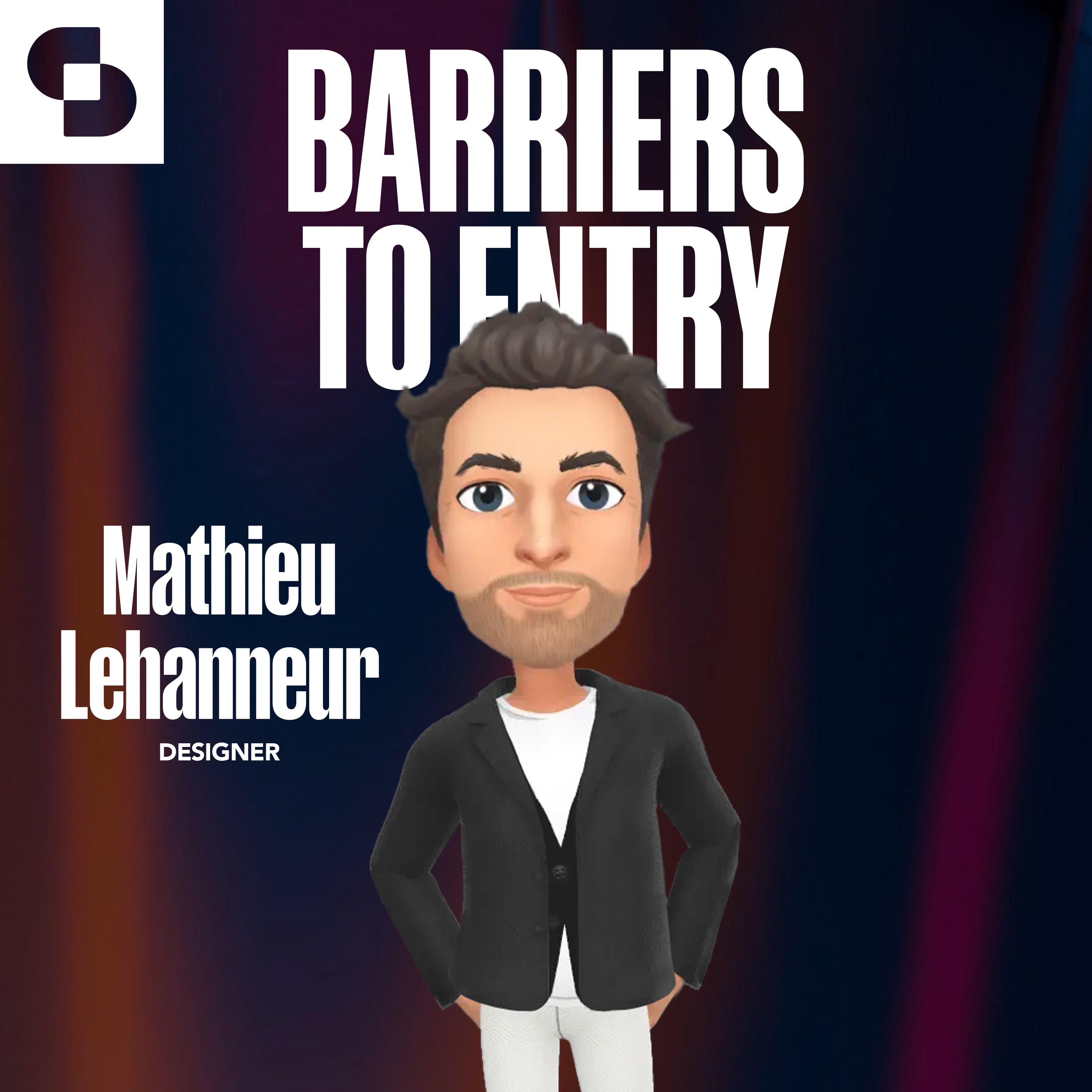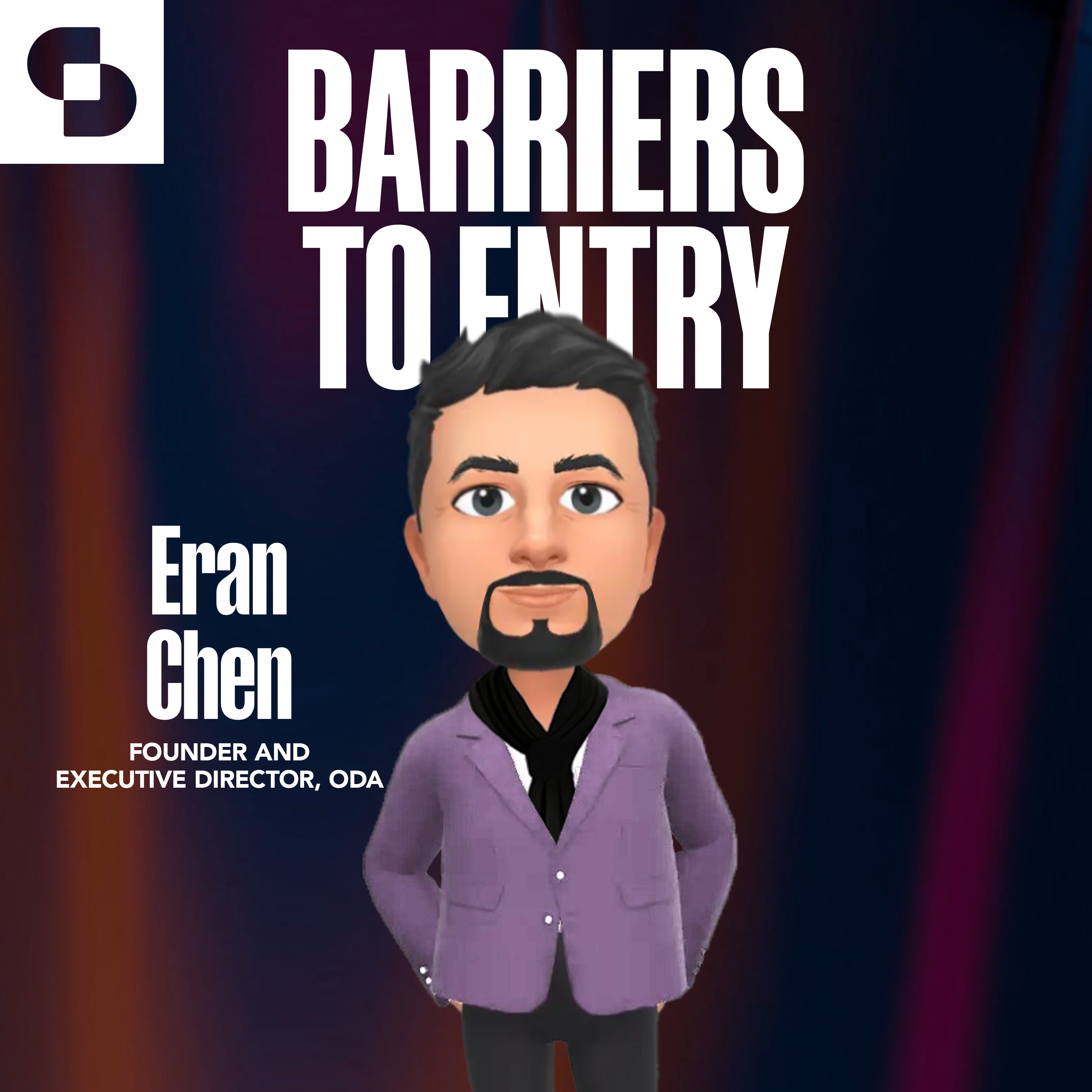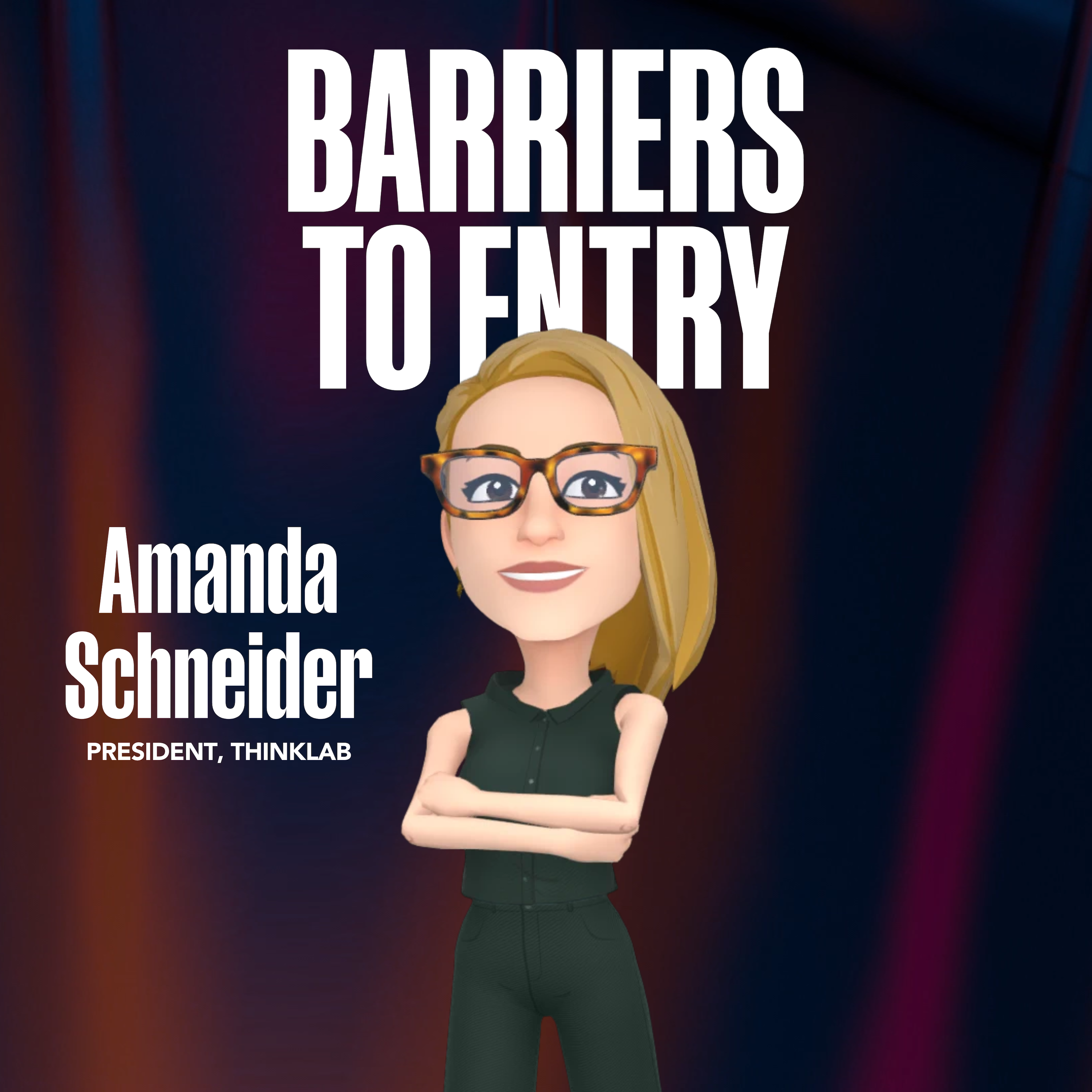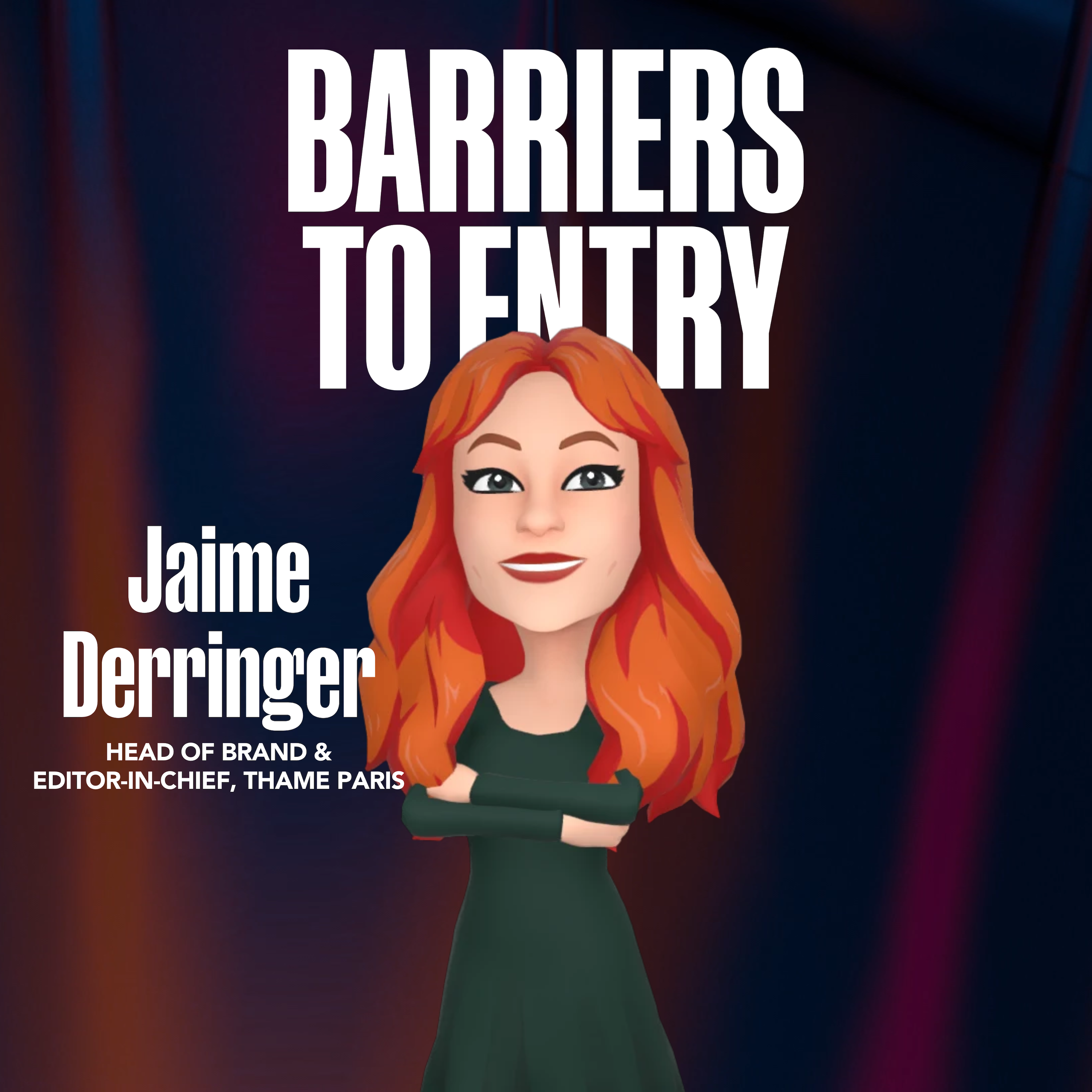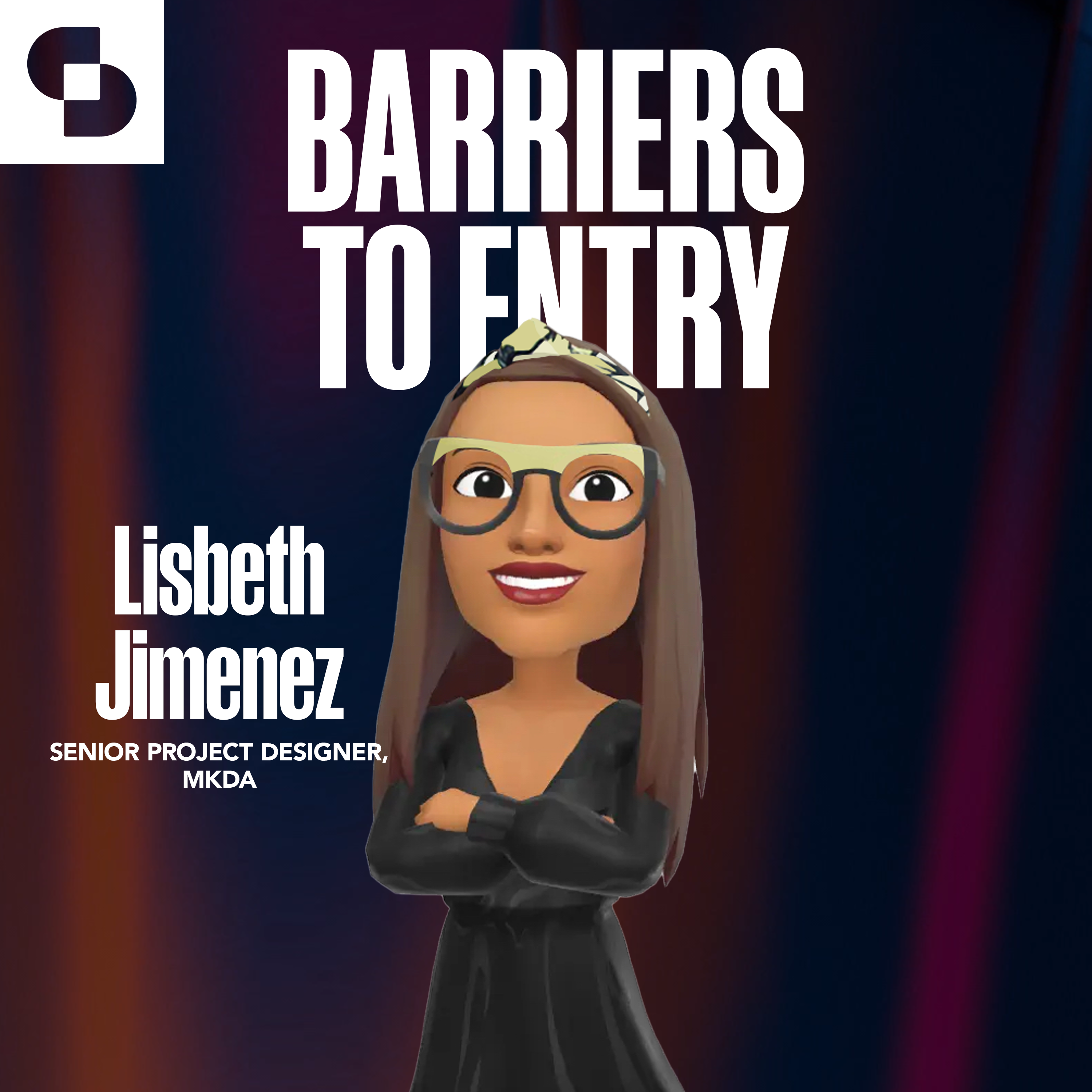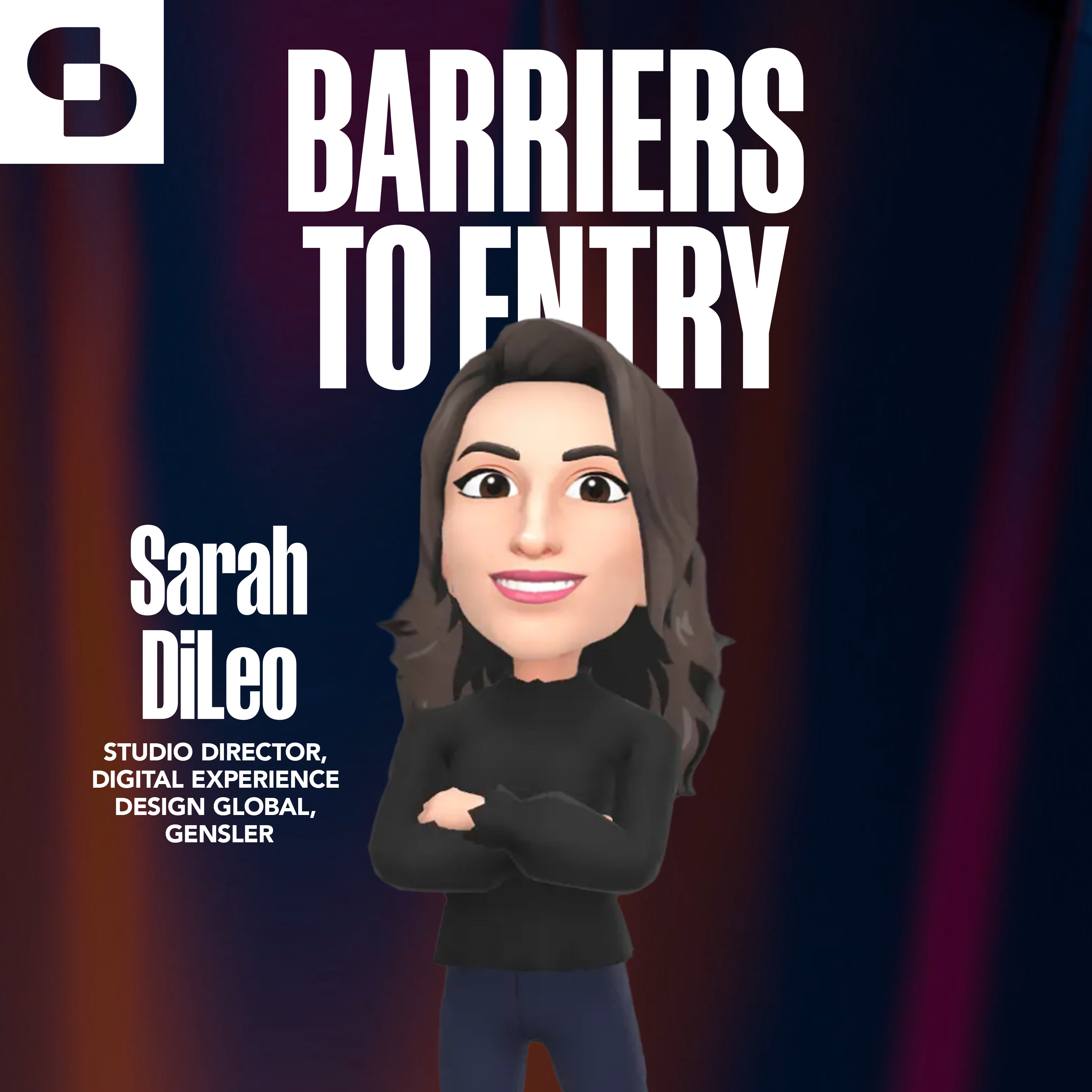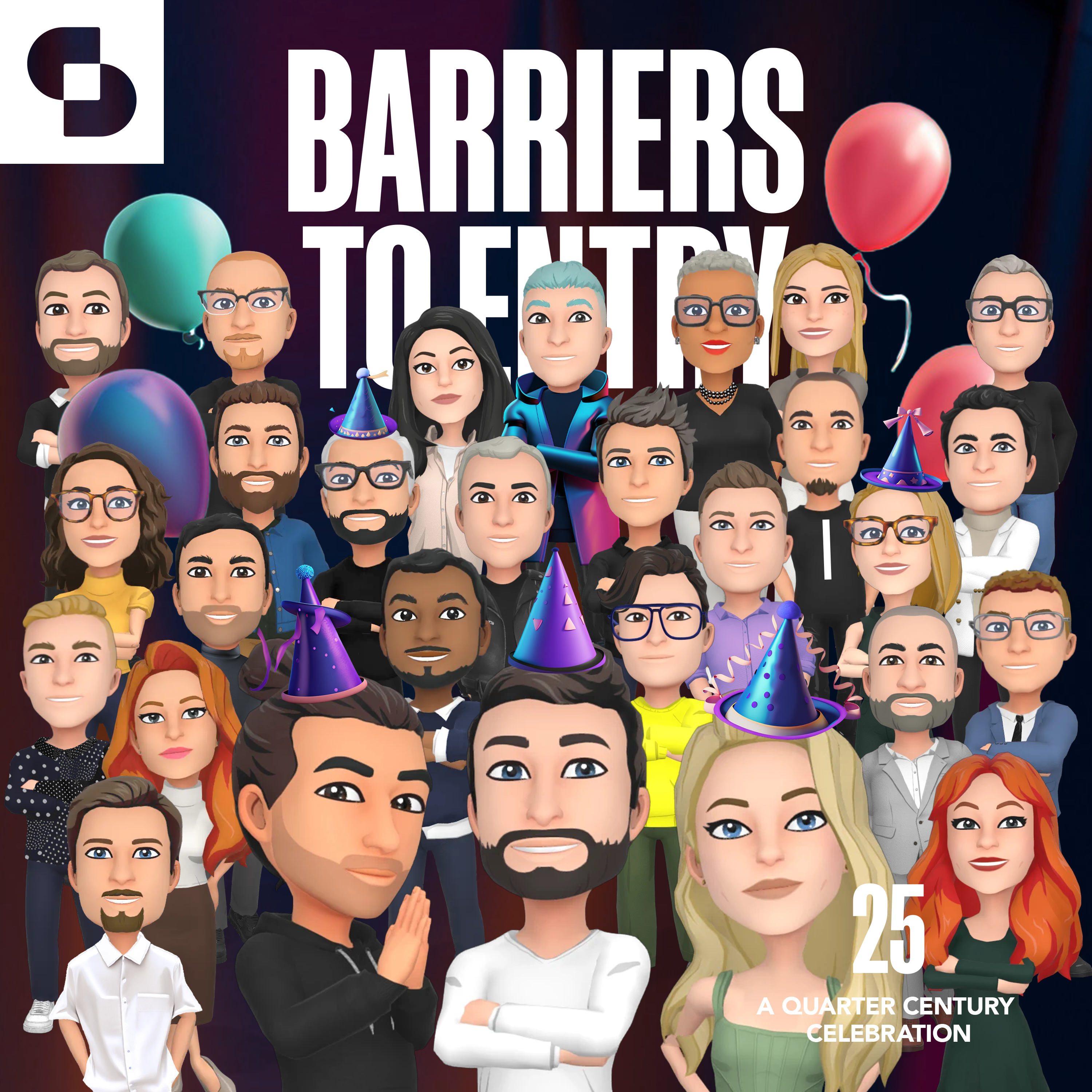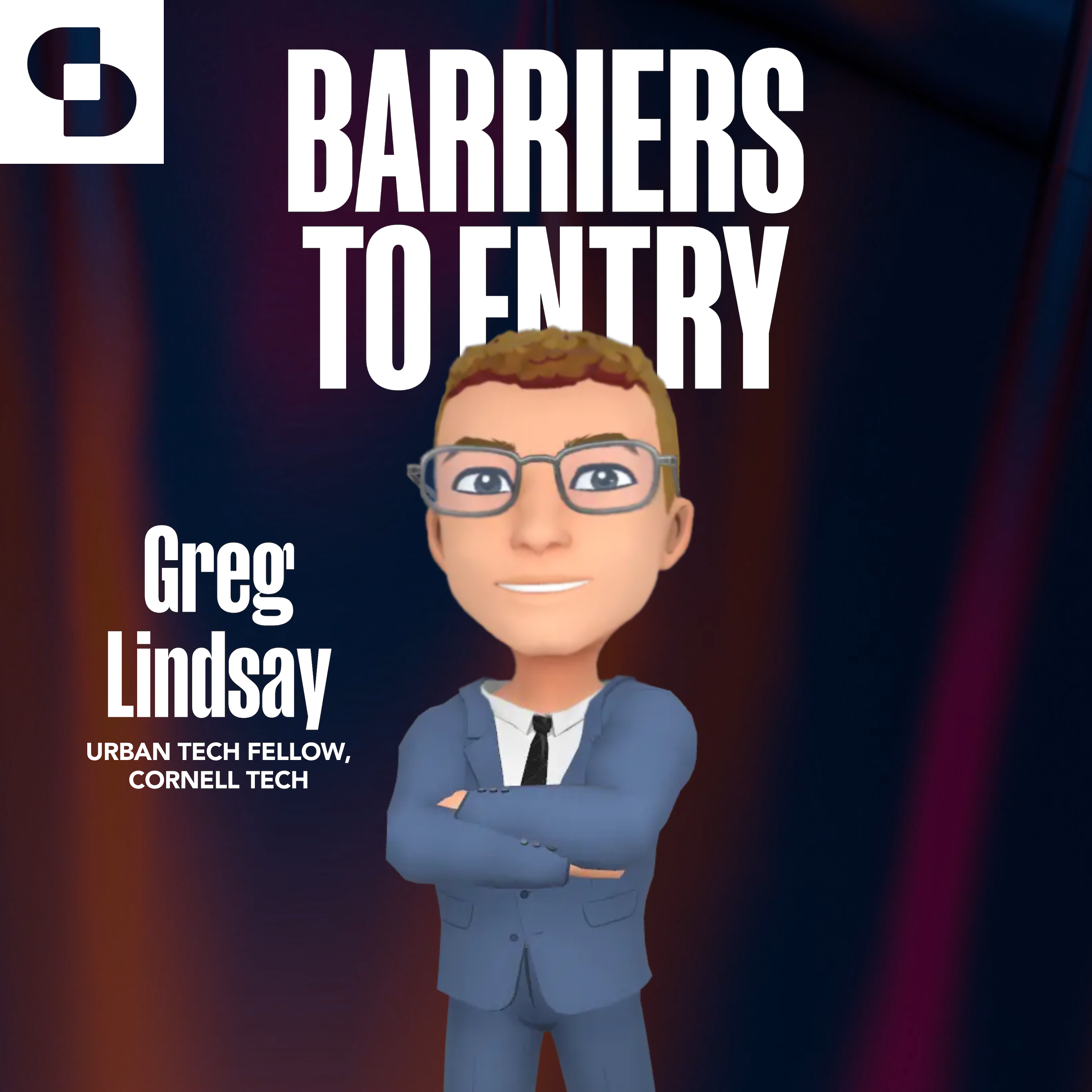This week, we sit down with David Schwarz, the founder of HUSH, an innovative experience design studio. In a conversation that moves from the philosophical to the practical, we go deep into the challenges and opportunities for both clients and staff of working with a design studio with technology and innovation core, discuss the future of work and the state of sustainability in emerging tech, share thoughts some thoughts on the questionably popular term, ‘phygital’, and even get into a little parenting advice with David and Bobby. If you’ve ever been offered a ‘metaverse watch’ from a guy in a trenchcoat, you won’t want to miss this one.
Connect with David Schwarz on LinkedIn!
Moments to check out:
- (6:23) The origins of HUSH as an interdisciplinary studio.
- (15:40) Delivering real value in a world of hype
- (22:58) Bringing your people along on an innovation journey
- (31:20) Designing experiences in the worlds of hybrid work and sustainable business
Connect with our hosts on LinkedIn;
References and resources:
Discover more shows from SURROUND at surroundpodcasts.com.
This episode of Barriers to Entry was produced and edited by Wize Grazette and Samantha Sager.
Although the transcription is largely accurate it was generated in part by an automated service. In some cases it is incomplete or inaccurate due to inaudible passages or transcription errors.
David Schwarz: [00:00:00] As a business owner, the hardest part is incorporating new things that we think have value into old processes, old, the culture that’s existed to date, the way, quote unquote, people have done things to date, disrupting that, re engineering that. It’s like a people challenge.
Bobby Bonett: Welcome to Barriers to Entry, the podcast where every episode we get into it with the leaders, the designers, the early adopters, and the influencers who are driving innovation in the architecture and design industry.
It’s the metaverse, it’s AI, it’s blockchain, and it’s all happening here. I’m Bobby Bonet. And as always, I’m joined by my happy and healthy co hosts, Andrew Lane and Tessa Bain. How are y’all doing?
Andrew Lane: Doing great. How are you doing, Bobby? Because we might not have been able to say you were healthy somewhat [00:01:00] recently.
Bobby Bonett: The interview will listen today. I was on like day one of COVID, but I’ve bounced back and I’m, I’m also emotionally recovering from the fact that USA basketball just lost to Canada a couple of days ago. So a belated congratulations, Andrew and Tessa, to both of you for your bronze medal win in the FIFA World Cup.
Thank you.
Andrew Lane: Thanks. It’s always great when we can win our first ever medal and have the chance to beat the team that wins all the medals to do it. So congratulations to your C team in placing fourth and we’ll see what group you’ve trot out for the Paris Olympics next year. It should be very interesting.
And Tess, I’ll let you finish the comment because I know you’ve been enthralled by my talking about FIBA basketball for the last two weeks.
Tessa Bain: You guys are trying to turn this into a sports podcast
Bobby Bonett: every time.
Andrew Lane: Always. Always. Do we want to turn it back into an innovation podcast? We better. So today we’ve got a really interesting guest, um, David Schwartz has been running Hush as a studio for 16 [00:02:00] years now, I think was the number and really doing some exciting work in the way that they design experiences and storytell on behalf of brands.
And I think that this conversation is just to be packed with so many exciting insights and really interesting points of view on how you sustain a business like that through a whole bunch of different economic ups and downs. But really, they’ve just been so consistent in doing what it is that they do and still here today and still innovating both with their clients and internally within their shop.
And we’ll also hear
Bobby Bonett: from David discuss how he is considering and being thoughtful about the ways in which being hyper innovative might not be great for the environment. So make sure you stick around for the whole interview to get into that. But should we hear from David now? Should we just get into it?
Andrew Lane: We should dive right in. Absolutely. Let’s not wait. All right.
Bobby Bonett: We’re hanging in the virtual studio today and are fortunate to be joined by the leader of a studio that has partnered with world renowned brands including Nike, Sonos, Uber, [00:03:00] Google, and Meta. David Schwarz is an award winning creative leader and since founding Hush 16 years ago, has made a reputation using art and technology to drive experiential design.
David brings amazing perspectives to what we’ll broadly call the future of design, and we’ll get into all of that today. Welcome to the show, David.
David Schwarz: Welcome. Thanks so much for having me. I appreciate it. One of your
Andrew Lane: first stops was at a producer at a studio that was called Total Creative, and I guess that was in San Francisco, kind of.
working in design function, but in around the time of the tech boom, not to date anyone here, maybe you can just talk a little bit about that experience and how that was a formative one for you.
David Schwarz: Yeah, that studio is not around anymore. It wasn’t around when I left because it was acquired by, at the time, KPMG Consulting.
So my experience there was watching it grow from like a four person studio to like a 60 or 80 person studio and then get acquired within, you know, [00:04:00] 24 months. So as a, as a
Andrew Lane: lifelong dream of any creative to be acquired by an accounting firm.
David Schwarz: Well, to be fair, it’s not that different than what’s happening and has been happening in the M& A market in the last five to 10 years.
And even still now in that these consulting firms are just looking for. The, the creative and strategic front end to power the back end of their technical offering and implementation services. So I, I guess I got a little look into the future, but I think what was most important was it was a snippet of time, you know, a couple of years, but when you think about what was happening in the world and in the internet and in digital in those two or three years, specifically 99, 2000, 2001, I mean, we saw.
Uh, sort of birth of the accessible internet everywhere, the ubiquity of it, the birth of a lot of companies that could only exist because of the internet at [00:05:00] scale, the birth of broadband, and then the dot com boom and the dot com bust. It’s like a rollercoaster ride that had all the chapters to it and it was compressed into such a short period of time, you know, you usually have to wait for like an economic cycle or a decade for those kinds of things to happen.
So for me. As a young creative, I kind of saw all parts of the deal. I saw how it could be when, when money’s flowing and Aaron chairs are being wheeled in by the dozens and you’re expanding, expanding, expanding. And I saw when those same chairs are being wheeled out and put into a warehouse and on fire sale.
And from a San Francisco moment, that was a very interesting. shift in the city. So you see how it affects your peers and your friends and what happens and entertainment and urban development and when money comes and goes. So I learned a lot very quickly. The other good thing about that job was that I still talked to the founder [00:06:00] of that company.
He gave me a shot, which is what is the only thing you. Really want, right? Like you have nothing to offer ultimately except potential. And I had a lot of potential and I thought I knew some stuff but I didn’t really know anything, but he gave me a shot and I just got in and started doing and helping wherever I possibly could.
And so I think that’s kind of a good reminder for me now of folks that I meet with who are quite young or early in their career. I’m looking for them to have the attributes and potential. That we can kind of co create and meld and mentor into something that’s really special. So anyway, I’m eternally grateful for that first shot because I kind of learned so much so quickly and Yeah.
It’s not unlike what we’re trying to do here.
Andrew Lane: And you said not long after that you, you found it hush. So maybe you can speak to what that initial vision was based on, you know, what you knew as 16 years younger self and how that’s evolved us into how you got on this [00:07:00] podcast. Really full circle
David Schwarz: there.
Yeah. Uh, there’s a little gap in years that I have to fill in, which is so part of being acquired by a global consultancy was also what happens when. The world is burning and what happens with a company. And so the, the boss of that company knew the end of days was coming deep in the second half of 2001.
And he’s like, what do you want to do? We’re probably not going to make it through this. You know, you’ve been a great employee. We can help exit in a fun way together. And I said, I don’t know. Like. I don’t know. I’d like to have a little fun and then go to grad school and he’s like, okay, I can help with that.
And so he helped me exit with some energy, let’s say, and I, I traveled a little bit and then, and then I went to grad school at art center in LA, which is when I actually first formally learned anything about design. I mean, everything before that was self taught or extracurricular or let’s say on the side I could [00:08:00] code a little bit.
I could draw, I could, you know, I had some architectural education, but I really couldn’t keep up with true designers or creatives in that way. So I went to grad school, I did a bunch of stuff and that’s actually what formed the basis for the company that we started a few years later. The model was just.
It’s incredibly cross disciplinary. So the model was really putting different types of designers and technologists and makers in the room and sort of starting from a nonlinear position, meaning Where did that,
Andrew Lane: where did that concept kind of come to you from?
David Schwarz: Well, I think the program I went to at Art Center was kind of flat like that.
It kind of gave you lots of ways to move laterally based on your interests or the ideas or the challenges you were trying to solve or explore. And that’s pretty atypical, you know, normally in higher education you have a track. And you kind of have to move through that [00:09:00] track and progress. So this was pretty non linear, which is great.
And I always thought that, you know, part of, if you’re, if you’re a filmmaker, you solve problems with film. If you’re a writer, you solve things with writing. And if you’re a designer, maybe you solve things with physical things or. Or graphic or whatever, right? To hammer everything is a nail. I thought that the company could be based more on a slightly wider set of design parameters in which the problem is the problem, but maybe sound could solve it.
Maybe technology could solve it. Maybe material could solve it. Maybe architecture could solve it. Maybe storytelling could solve it. And I think that was the higher order of, of idea. For the firm, you know, it was a lot more pragmatic and practical on the ground, but that was sort of something we fell in love with.
It actually took a few years to get it to kind of do that, but it was a goal there [00:10:00] for sure. Cause I had been working with my partner in a bunch of permalance roles, uh, doing a lot of commercials, television, like linear filmmaking, animation and storytelling in those forms. So content and a bunch of interactive and web stuff at the time.
So that was sort of maybe our. Our knowledge, but it wasn’t what we wanted to continue to do. Yeah.
Tessa Bain: Give us an example of the ecosystem of design from like architecture, design, development, and then the execution of a project. Where does Hush sort of fit in in that ecosystem?
David Schwarz: It’s a great question. So, well, I can start from the end and go to the beginning.
So, We make experiences in the real world. So the word experience is pretty rough these days. It’s kind of in the eye of the beholder. We’re talking about real places and spaces you walk into. Of course, there’s all sorts of virtual meta mixed reality layers. We put around it and add, but I would say at the.
End of the [00:11:00] day, things we make, you can show up to in a real place, maybe many places and experience with your own human body and all of your senses. So working back from that, since we’re doing it at scale, the scale of corporate campuses or lobbies or skyscrapers or exhibitions, you know, those ecosystems are filled with lots of players and very important processes and entities.
So we. exists as this layer between the architecture and the people that experience the architecture. So I think where architects build buildings and spaces, and maybe filmmakers tell stories and narratives, we’re sort of that in between. How do spaces Tell important stories to people, you know, it’s easy to say when you have a exhibition or you have a retail space, you know, where there’s product you want to sell and customers who want to understand that, but we’re stretching the idea of storytelling as far as possible.
So story for us in an [00:12:00] architectural space could be a soundscape. It could be a data visualization. It could be. a sculpture and objects that are created in a certain shape and form to talk about their materiality. It could be an interface that helps you understand the data that exists inside the building all around you.
So I’m giving examples, but it’s this sort of middleware between the built environment and the people that operate within it. And That’s quite a bit of stuff and it can be on quite a large spectrum, but it’s a simple way to say it.
Tessa Bain: Are you hot or cold on the term figital?
David Schwarz: Oh, so cold. Freezing. So cold. I need like a big jacket.
Tessa Bain: Listen up everybody. David Schwartz, cold on figital.
Andrew Lane: The unofficial hot or cold poll is running pretty cold right now for
David Schwarz: sure. I think what’s more interesting than the word figital, It’s almost everything, but what’s interesting [00:13:00] about the concept of a word like figital is that everyone communicating about this area of design and creativity is searching for something more explicit and articulate to describe what took me five minutes to tell you just then.
And it would be amazing if there was a simple word that summed it all up. But because we’re all kind of in this swamp together, we’re trying to create our own nomenclature. It’s a great branding tactic, but it’s a really poor communication tactic. Because it
Andrew Lane: brings you to a semi common place quickly, but then you, then you have to unpack all the preconceived notions that people have about the term before you can
David Schwarz: move forward.
Exactly. Exactly. Yeah. Trust me. I, I, I think we struggle with this all the time and it’s unfortunate to Be in a sort of industry that’s really quite large and growing and still be struggling with the language to describe it. If you look at other fields that have been [00:14:00] around for longer, you know, they’ve aligned on an on a nomenclature of what it is and what it isn’t, and that just simplifies it because.
The work is hard enough and complicated enough as it is. If I also have to make up a whole new language to discuss it, then I’m adding another layer of difficulty. So I don’t know. We try to keep it simple. Show we show don’t tell a
Andrew Lane: lot. How do you get started then? Given that Figi is not clearly your kickoff point, where does the conversation start?
Is it an architecture firm that’s bringing you in? How do you kind of become engaged?
David Schwarz: Great question. And for someone like myself who’s sort of on the front lines of. A brand representation, which turns into kind of business development. That’s important. We always engage with the end client. and there’s a reason for that.
If you’re in charge of articulating, An entity’s most meaningful and important stories are ideas in the world, like what they stand for in the [00:15:00] world. We don’t want to be mediated through any third party, right? You need to truly be able to do the strategy, the research, the discovery work with the key stakeholders, be that C suite and all sorts of other key leadership.
And if you’re not hearing that, processing that, curating, editing, churning through that direct from the source, it’s like there’s a level of vibration and dissonance that happens in our ability to then do something that is truly ownable and unique for them. So that’s kind of the ideological reason for the direct line of work.
But that being said, we work with so many other peers. In that ecosystem who are also responsible to deliver something for that client. So like our success can’t happen without our colleagues and these partners, much like an architecture firm or AB systems consultant or a third party technology team or the product teams or et cetera.
But we maintain a [00:16:00] direct line. So we have that sort of shorthand and clarity I’d say in storytelling. Well,
Tessa Bain: based on the work that you do and the boom of the acceptance of this type of technology, let’s say in like 2021, 2022, we saw a lot of people kind of, I’m going to drop the metaverse word here a little bit.
You know, I’m just so curious, did you see like the requests that your firm was receiving start to shift with that boom? And then how did you kind of work as. An innovation lead saying, like, here’s the request I’m getting, what’s the value behind it? What’s, you know, the utility behind this request? What’s the end goal based on your comment where you’re working directly with that
David Schwarz: client?
Let’s call it in the last three to five years, I would even go back to say. And I think this idea of digital experience, be it totally virtualized metaverse for hybrid models or enacting things in the real world that are technologically enabled, became kind of high on people’s lists, [00:17:00] high on organizations lists to start to lean into for a variety of reasons.
Thanks. The problem is that some people just wanted cool stuff because everyone else wants cool stuff. And so there’s a keeping up with the Joneses, especially on the level of corporate angst and scale, right? If Meta does it, Google does it. If Google does it, Uber wants to do it and so on. And it’s not, it’s just about.
So I think what we help our clients do, or even if they’re not clients yet, but they’re inquiring to us, I think we help them rebrief and really try to understand what the end goal is and not the technological path they might have been heading down when they first reached out. So I think it’s a little bit of that challenge.
It’s not about being. Disinterested, it’s about fortifying the demand for what we do or what they think they want. And if we can’t kind of co [00:18:00] create the rationale for it, we kind of realize that maybe it’s not the optimal path and we can kind of reverse out, rebrief and go down a different path. So I think it’s a little bit of a political answer, but the idea is that.
No one’s calling us for a thing. They’re calling us to help them achieve something. And we may choose one of several things we want to implement for them. But it’s not what we don’t, we’re not like opening up our trench coat with a bunch of metaverse watches and a bunch of mixed reality headsets and like, what do you
Andrew Lane: want?
That’s a great visual. That’s a great visual. Yes. But I mean, at the same time. I mean, there is a trench coat, so to speak, right? Like you do stay apprised of what’s happening in all sorts of different technology disciplines in order to be able to create and deliver the experiences that end up becoming that solution that you just spoke to.
So what are you doing internally within your shop to [00:19:00] encourage that kind of exploration, ensure that you’re staying on top of what is possible out there from the standpoint of that experience layer that you’re creating?
David Schwarz: Yeah, that’s a great question. And it’s something my. Founding partner does a lot of right, so he’s the sort of c t O of the business, which is, everything matters until it does.
It, I think, is maybe a a good way to start. How do you keep the aperture open Very wide. To really think about all sorts of changes in technology and new evolutions and advancement, software, hardware, materials, pipelines, processes, information sources. How do you do a light level of investigation across so many things?
But then be able to pick the diamonds from the rough and so to speak. And not everything’s rough, but they might just be rough for our studio, right? And when I say rough, it’s like maybe just not right for what we’re pursuing. We might have value in many other places. [00:20:00] So his role is to constantly be looking out there, constantly be feeding stuff back into Hush, the engine of Hush, so people are aware of it.
So that awareness is kind of half the battle, which is frankly a full time job. It’s all consuming at the rate of change, right? So you need to have someone who’s constantly churning, watching, demoing, going to see the latest, greatest, getting the early version of the headset so we can test it, the betas, et cetera.
And that’s this machine that constantly moves. The trick though, is I think connecting that to business rationale, right? And so I’m the business rationale. So if I know what our business wants to do in the world, what our value proposition is, cause I’m hearing it from our clients, we’re delivering projects that have impact.
We, it’s kind of that echo effect. Then I’m constantly feeding my partner. Thoughts around where value could exist and why, and maybe we’re giving value in this thing now, [00:21:00] but there’s about 10 or 20 percent on either side of it that we need to explore because it’s right there. We just don’t know exactly how to integrate it.
So that kind of information to my partner, some technology leads, and of course, like to the rest of the team means just we’re connecting the potential. Of the landscape technologically with kind of what’s being demanded of us, or could be being demanded of us in the near term. So that’s like the first part.
If you have one but not the other, it doesn’t work. So I could be sitting there going, Hey, it sounds like we wanna explore more about data and we need to understand where this data exists and if it’s in a clean form, and how can we can access it and da, da, da. And if my partner hasn’t been looking into that in a way that makes sense, then it’s just falling on deaf ears.
Vice versa, if he finds a solution like a data trove or a new particular API that’s now robust and exists, but I’m not here to say that has value to our customers, again, it’s a one way conversation. [00:22:00] So I would say that’s the big ideas. Like we have to have these two parts, but I can say as a business owner, the
Incorporating new things that we think have value into old processes, old, the culture that’s existed to date, the way, quote unquote, people have done things to date, disrupting that, re engineering that, it’s like a people challenge. People, they exist to like optimize and make themselves more efficient and faster and smarter and better.
But when you want to create something that’s inherently inefficient, cause it’s new, it’s untested. It’s like this variable added to something that was quite, you know, quite beautiful and the way it worked is like an engine. It’s inherently inefficient and frustrating for people. And so I think your job as a business leader is to say it’s going to be frustrating for a second, [00:23:00] maybe more than a second, maybe a business quarter, maybe a year.
But if we can get through it and adopt these new opportunities, often technologically, we’re going to accelerate 3x after that, but let’s just all tear that muscle together. And that’s actually, I think that’s actually more interesting and it’s hard. You see the fruits of that labor.
Tessa Bain: What are the ways you go about getting your team engaged?
You set out firm mandates and say, we’re all going to try this. We’re going to pilot it. Do you? Just kind of encourage without mandating like what’s your approach?
David Schwarz: That’s great question. I think we’ve probably done very
Andrew Lane: complimentary to our
David Schwarz: Appreciated
Bobby Bonett: that also if
Tessa Bain: you’re nervous that anyone know your firm’s gonna listen and be like he mandates it.
What’s he
David Schwarz: talking about? No, it’s okay They give me a hall pass for almost everything. I say that goes out onto the internet So the short answer is We’ve tried everything, right? Sometimes it’s a push, sometimes it’s a pull, sometimes it’s a mandate, sometimes it’s [00:24:00] a put it out on the table and wait till someone picks the thing up kind of idea.
So I don’t want to be so vague. I think
This is human psychology, right? There’s like a kind of three part system. It’s, you have to expose people so they’re familiar, right? They know what that thing is called. When you’re using a certain language or you’re talking about a certain thing, they’re like, oh, I know what that is. It’s not scary. So you sort of like take the fear away from it just by using the language, pointing to it, sharing a reference on Slack.
You know, hey, this new thing came out. You should check it out. That’s like the old thing that came out. We should look at this. You know, you’re seeding it into the culture. Maybe not everyone is diving into it top to bottom, but they’re, it’s becoming familiar. That’s step one, right? Step two is then small task using new thing leads to positive outcome, even if it’s super tiny.
So it’s like that little Pavlovian [00:25:00] effect. It’s like a little, it’s not scary. I can do X plus Y equals Z. And it’s not going to change the world at that scale, but I can make the equation happen. And then the third part I think is when they see value and the seed of value, and we see the seed of value, and we can see like a little bit bigger and farther into the future, kind of like a constellation of how this could all change things for the good forever, then I think we lean in with a sort of mandate, like, Hey, on this next project.
Now that you all know what we’re talking about, you’ve all tested that one little thing. It seems like pretty cool. Let’s all agree. We’re going to do this together on this. And you know what producers, it might mean that we’re a little bit more inefficient. Our margin is going to go down a little bit team of makers.
You’re probably going to stumble more than you normally stumble. It’s okay. We’re not going to be as crazy in our reviews and [00:26:00] expectations. We’re going to know it’s going to take a little bit longer to get to where we normally get to be an existing means. And so you give all these passes for like what you know is going to happen based on this new process, but we all hold hands and agree that this is what we’re going to do.
And so that’s the mandate part, but it’s not mandate without building that. First two pieces up,
Bobby Bonett: I think. And your team believes those passes are legit at this point, that, that, you know, you’re not going to say, Hey, we’ll, we’ll forgive a lighter margin on this project. And then three months later, we’re like, well, the margin on this project sucked.
What happened?
David Schwarz: Well, here’s how it goes. If we agree, we’re going down this. the more efficient, the most inefficient, potentially painful or circuitous path to achieve something in additional to the final outcome, margins pretty easy. If we make X normally or between X and Y normally, we’re going to say we’re going to make X between X and Y minus, you know, 3 to 5%.
Now we have a smaller margin, but it’s still a target. If it goes below that, we have a lot to set, but we agree on the risk we’re taking and the [00:27:00] inefficiency we’re going to bear for the, it’s an investment in the future.
You know, I don’t think we will never say we’re going to accept less creativity on this one because we’re trying new things. I think there’s an expectation that if we’re trying new things, everyone’s going to get it to where it needs to get to from an A plus standpoint. And it might mean. Some more hours and some later nights and some more frustrating moments, but also some more satisfaction and success.
And frankly, most people creative just want new anyway. So it’s, it’s the ability to give new, I don’t know. We have a culture that is like. I always compare it to sports, even though no one here plays sports, except for me. I’m always like, you know, player, coach, and they’re like, what? I don’t know. I never had a coach.
I think it’s like a coach mentality, right? It’s like, there’s a safety in the team. You’re on it together. You’re all part of the same team. You don’t tolerate BS [00:28:00] between players and stuff like that. That doesn’t mean. There’s an acceptance of less than, you know, premier league level effort. And so that’s kind of what I’m into.
And I like that people come here and they have a career and it pushes them. And now that I’m older, I’m excited that even if people don’t stay for a decade, they go on to do amazing things. And I can. Yeah. You know, and it, it’s cool to feel that that’s what you’re, what you’re giving people, you know,
Andrew Lane: that’s awesome.
We’re, we’re, we’re all about references that go over people’s heads here on the pod. But I was, I’m curious, you know, you’ve talked a lot about the team and holding hands and those kinds of, um. Expressions. But how is it that when you’re going through these processes of change, are you soliciting the feedback and are you getting the team to feel they can come forward with an innovative idea or a piece of feedback?
And sort of how are you rationalizing that as the business leader? So that to Bobby’s point, people do feel like you’re worthy of your hall pass and that you’re [00:29:00] really hearing
David Schwarz: them. Okay. So that’s a complex question. I’ll change my attribute. It’s complex because on one level you need to seek some privileged private.
and safe information and feedback, and you need to create the space for that. And at the same time, you need to openly and publicly demonstrate that you’re willing to watch people fail and pick them up and keep them going and still try to get to that goal line that we’re trying to get to. I think actually, over time, we’ve been much better at the latter than the former.
Meaning, a culture where People are able to make mistakes and their peers will be like, Oh, you know, I can help you with that next time. It’ll go a lot faster. This is what I did when I hit that roadblock last time, or let me let you in on this little way we do this and it’ll help you in the next sprint we have to do in this [00:30:00] way.
And Hey, did that work for you? Cause I could do it and you could do this other thing. And you know, that kind of lateral conversation where everyone’s in it for the collective goal, not in it for themselves is something I think we built into the culture How did that happen? And that happens when like an intern can come up with an amazing idea and it actually happens.
And then that’s the idea that we go with and we spend the next three to four years making something that came from the seed of a very young, new person. And you can say that, or you can just make it happen. It’s like the best idea wins, the best thinking wins, and no one has any grudges.
I don’t know how we got there, it’s just a kind of vibe thing. I do remember when I was freelancing a lot, prior to starting Hush, you know, I would sit down in companies where we’d all be working for the same client, but the people I was sitting next to, we’d be competing. You know, competing for [00:31:00] our design.
I remember, you know, you do stupid stuff, you got to sit down, you got to clean up some artwork or something to use it for a design idea or like a CAD file you have to simplify down or some thing you got to turn into vectors or make into layers or, you know, some production level design work. And you’d have 10 people all doing that.
Next to each other. ’cause no one wanted to give the person to the right or left of them. The advantage of already having done that, Hmm. And I thought as a business owner, I was like, if that happens at my company, what a waste of time. What a squandering of like, opportunity to actually be putting that against real interesting creative ideas.
And so that’s kind of where, where it came
Andrew Lane: from. Do, do you feel it works? As well in a hybrid work scenario, or are you guys an in office in person type of a shop when it comes to that kind of collaboration?
David Schwarz: Because as you imagine, you know, the last three years has been very. [00:32:00] stressful on every business with people, which is almost every business.
And we’ve all learned so much, we’ve all made a ton of mistakes. So now that we’re here, we made it through the pandemic kind of anchoring a little bit into old school tendencies, not in anything that would endanger anyone. Physically or psychologically, but
Andrew Lane: Dr. Fauci doesn’t listen to our podcast, so he can
David Schwarz: speak quite freely.
Yeah. We had Fauci’s reports going on, we were spreading around, everyone knew what Fauci and team was saying. I think. And it was more like we spent a lot of time thinking about what like our DNA was. And at some point, if you start losing your DNA, you start losing, losing like what it means to be hush and what that company means to our clients and each other.[00:33:00]
We made it through like the most difficult times to keep a physical studio. We made it through. So why did we do that? Why were we fighting so hard for that? Why did we keep paying a lease? You know, why, even when no one was there at some point, you’re like, I don’t know. It just feels like the right thing to do.
And we did all this stuff, right? We mapped all the in person, all the virtual, we did all that. And of course, now we have a new sort of hybrid model and we’re here three days a week and we have flex days and people go remote for weeks and whatever, but, and frankly, we just like stopped caring. So it was just like, whatever, everyone has a responsibility to make great work in certain scenarios.
It’s hard to make great work, especially when you work in the real world. So how do you do like a materials review, an industrial design review, a physical prototype review? How do you do that virtually? You really can’t and still produce good work. So there’s certain times which. Everyone understands like you got to be together.
So anyway, I think we just realized like our special [00:34:00] sauce and what was core to our business as an output is rooted in the real world in many ways. And if we’re not like living that as a group of people, then how are we going to articulate the value of it to our clients and have them resonate with what we’re making?
And, you know, if we were building pure software, I might have a totally different. Paradigm about this, but at the end of the day, we’re talking about real people with their five senses, experiencing things at a higher order level of understanding, artistic, ideological, philosophical, academic, informational.
And we’re trying to feed that to them in this 360 way where they can hear it, they can feel it, they can touch it, they can do things with their peers, they can bond, they can leave different people than they were when they came. How can I? Sell that and make that, and then have our whole team be distributed, not really knowing each other, not really being with each other, not really holding hands, not, you [00:35:00] know, it just, it doesn’t equate.
So when you get rooted back into the business vision value set, and you think about, you know, r t O and hybrid, it starts to answer itself pretty quickly. And lastly, I’ll say, I don’t really want to run a business that’s purely virtual. It’s like personally, not that satisfying to me personally, what’s really satisfying is like me going and like walking around and looking at stuff and being amazed by something I see and asking and having a whole conversation with somebody who maybe I don’t even know that well cause they just started.
And then you can meet someone cool and you realize they have all history and they have these connections that you didn’t know. And then you start to talk about what they mean. That’s why I personally do what I do and it’s, if that’s gone, I should go live on a farm, which sounds awesome, but not what I do.
Bobby Bonett: So if, if I can kind of just summarize the firm’s identity today, David, 16 years after you founded it, you’ve been on this treadmill of innovating and now, you know, further complicated Maybe if I’m to [00:36:00] extend the treadmill analogy, we’ve turned the speed up to 12 miles per hour these last three years. Do you feel really solid about the identity of the firm and how you’ve positioned yourselves where you want to be as, you know, the firm leader and, and, you know, as your staff is set up and where you’re positioned to continue to tackle?
New technologies, new opportunities going forward.
David Schwarz: After 16 years, I can tell you like, just when you think you’re clear is like, is like the death moment, you know, just when you think you got it all packaged up and you feel like you’re meeting the market and you’re excited and you’re like excited to make what you’re making is when everything starts to fall apart because you think it’s not going to change.
So I’ll sort of reframe the question. I’m excited about where we are right now. I’m not dumb enough to think we have it all figured out because right when you focus on target X, it’s going to move and you’re going to have to rethink a little bit how to get where you want to go. About three years ago, we started reinventing and I think what’s [00:37:00] become a new hallmark of our work, and we’re still in development and refining and building better processes, is it’s not big tech for big tech’s sake.
It’s not tech creativity and innovation for innovation’s sake. It’s not big media for media’s sake. It’s for creativity’s sake, and we may leverage technology in that, and we may understand that technology is not sustainable. A poor indicator of sustainability. So we might design in things that offset that or consider it one attribute of many that we wanna make as part of like a great concept.
So we’re just rigorously looking at the work and if we present energy, heavy, carbon, heavy ideas, Hopefully, the only reason we’re doing that is because that’s the only way we can solve the client’s problem. And the other solutions we have are other smart solutions that might be better for the world. So if we just got through a phase of work for a big developer, [00:38:00] large campus, life sciences, very cool, really interesting, also very sustainability.
and conscious. Through strategy, we got to a place where we had to do something pretty big and rich digitally as a storytelling piece, because they had to tell this story. And at some point, you’re, you only have the tools and platforms that you have at your disposal. So that is a piece that I would say marks lower on the sustainability.
Checklist. But we did all these other things in the rest of the spaces that were highly analog, interesting use of materials, sustainable, not heavy, intensive carbon, really low energy use. So we looked at it as a holistic idea. What does what where, and that kind of balance and nuance is essentially the strategy of the firm.
Bobby Bonett: Where does that fall on the spectrum between frustrating and a fulfilling challenge for your staff?
David Schwarz: It’s super, super fulfilling because everyone here cares. They just, it’s, we go back to the start. How do we learn about [00:39:00] things that are innovative, technologically new? Like now we’ve opened up a whole world of ideas and information to them.
Now they’re looking at material libraries and research. We’re getting materials consultants in to talk about how we could rebuild things. Our fabricatory partners are now, we are choosing the expert fabricators who understand how to quantify impact and carbon accounting for each of the pieces of the puzzle.
We’re building smarter things. On the technical side, AV systems providers are now looking at more sustainable sourced technology and hardware. We’re looking at energy costs and data platforms that help us understand that for our clients. It’s like, to me, it’s even cooler. We get to learn more about more and float that into the design.
So it’s not a burden at all. It’s like the next chapter of our own careers in terms of education and learning. You know, so, yeah, that’s really
Andrew Lane: exciting stuff. Really exciting stuff.
Bobby Bonett: David, is there anything you’re working on at Hush that you’d like to share with the BT listeners
David Schwarz: right now? Yeah, I mean, I think we can plug slash just like create the right [00:40:00] vibes to have like the things that we want to come our way, come our way.
So vibes would be. From a client standpoint, if you’re out there listening, if you believe in these kind of value systems, if you’re engaged in interesting and innovative technology as it relates to life sciences, biotech, mobility, EV, that’s subject matter. We want to also help bring to life and storytelling and space for people above all else.
I mean, we’ve told stories for some of the best. It’s not that that’s not interesting and great, it’s just that I think we have meaningful and rich knowledge and material for those kinds of industries. So that’s one. Two, I think for vendors, partners, et cetera, all the folks that help us do the things we Do you want to work with the people who share the ideology that I just set so that they’re rethinking their own businesses in the light that I’ve shared where we’re thinking ours.
And so no one’s coming to us [00:41:00] with, you know, commodity unit based thinking. Oh yeah. We got a bunch of this stuff with, this is what it costs per linear yard. This is what it costs. You know, they’re selling a collaborative service so we can help. Clay of ideas together, which will mean inefficiencies on their end, more complicated processes.
But like certain firms want that because they want to achieve the outcome we want to achieve. So that’s, those are who I want to be talking to and calling. And then I think lastly is just talent. A lot of people were fortunate to get inquiries from talented folks, but I think we can always. Get more, I think the barrier for any of those inquiries is simply the idea that, um, what they probably do best as a skill, whether they’re a designer or a software developer or an architect or project manager or producer, they’re unsure how their best treat and skill will apply in our world of experience design.
And that kind of fear. might stop [00:42:00] them from taking that risk instead of pursuing the channel that they’re pursuing. And they could probably be very successful continuing to grow there. I think I would ask them to take a risk anyway and know that we’ll take that best skill and apply it to so many different things that they’ll spread their ability and tear new muscle in a way that I think is just satisfying for anybody who’s creative.
So it’s more of like a challenge for them.
Tessa Bain: I feel like that’s a really good segue. Into our standard final question too, which is always, you know, resources that you have or advice that you want to share with our listeners and the design community, you know, at
David Schwarz: large. This industry is still forming, even though it’s been around for decades in other forms, right?
Ever since there was a place to visit. And people to tell stories to, we’ve had some sense of experience design. I think it’s become something that there’s conferences about and groups and societies you can join and, you know, events you can go to, to see the latest, greatest and exhibitions. [00:43:00] And there’s blogs and Pinterest boards and Instagram channels.
So there’s more formal ways to sort of see the landscape than ever, but because it’s naturally like an in between space. It’s not as clear as branding and identity, or SaaS product, or technology hardware, or furniture design, right? There’s plenty of gray area in each of those, but I think we know what we know when we’re talking about those things.
So because it’s sort of enigmatic and it’s this in between space, my recommendation to anybody listening and is interested is just make it what you want to make it. So it’s almost like write your own future based on the ingredients you have versus waiting for some perfect sandbox to be built for you to jump into and do that.
And I think that’s what anyone who works in this industry and anyone who started a company in this industry and anyone who’s been riding the waves over the decades, it’s really. You know, you’re inventing it [00:44:00] as you go and you’re talking about where you want to explore into and where you want to move away from.
So that’s certainly what we did. You know, no one gave us the script. We just started making the things we wanted to make and started to formulate why it’s different than other things and why it matters and why it has value. So I’d say anyone can take that and sort of personally activate that same sentiment.
Love it.
Andrew Lane: Well, David, thanks so much for taking your time to join us today and for sharing all the stories and the points of view. It’s always great to have a leader like yourself on to talk about, you know, how you made the thing that you made and how you’re thinking about always evolving it. It’s, it’s just such a, an exciting topic always for our listeners to hear about it.
So can’t thank you enough for spending the time and sharing the point of view.
David Schwarz: Thank you.
Tessa Bain: All right. Well, that was a really cool talk with. David You know, one of the things he touched on that I thought was really interesting is the way in which they fit into the ecosystem of design. It’s a little bit different than any of our other guests before and how they leave with their projects.
So [00:45:00] storytelling being something that’s so important to David and his team and the narrative that they’re kind of weaving as they go throughout a project and how technology is starting to to play into that as being the thing that they don’t start with because they do start with that story and that greater concept, but it is a part of how they actually execute on their projects.
And so that was really interesting to hear
Bobby Bonett: from him.
Andrew Lane: Yeah, it was great to hear just the way they structure that too, right? Like with the design thinking coming first, but also the way that he works with his chief technology officer and partner around the way that they think about exploring the landscape of everything that’s out there and understanding what’s out there.
And what’s going to be right for them and for their clients. And maybe what’s not like just having that strong understanding. I really love pulling the thread on that with them and just even understanding the way that they think about the internal innovation that’s required in order to do that and how they’re constantly putting stress on their own system to evolve and continue to evolve in the name of telling the best stories.
Bobby Bonett: Yeah, I was really appreciative [00:46:00] of how often you referenced it just a moment ago there, Andrew. David was willing to draw back the curtain and give us a sense of the inner workings and the inner machinations of Hush. And that was super prevalent and particularly interesting to me when he talked about recruitment.
You know, when we think about brand marketing, and David seems to be an outstanding marketer, among other things, as one of the founding partners of Hush. Two things that brand marketing does really well, or contributes to in a really important way to your business. One is competitive moat. And one is recruiting and David definitely seems as we hear about the process, we hear about the way in which they integrate into projects has a competitive moat as it relates to how they contribute and they implement and import themselves and design projects.
And I could definitely tell as David was discussing the way in which they’re acquiring talent that he’s got folks who are probably sending. Him their resume asking for a spot on the hush team, and I think that’s you [00:47:00] know a byproduct of the thoughtful way He’s curated that design firm over 16 years and the story like you said to us the story that hush is told Um, since he founded that organization, um, a decade and a
Andrew Lane: half ago.
It’s always great when we can get someone to tell us like a significant portion of the special sauce ingredients and Dave was great for that. It’s like having Colonel Sanders on and getting like at least eight or nine of the herbs and spices.
Bobby Bonett: Interesting.
Tessa Bain: Bobby, I had to Google machination, which is kind of embarrassing to admit on a podcast, but I thought that that word was very special.
Thank you. Yeah. So well
Bobby Bonett: spoken. Well,
Andrew Lane: it was a special conversation, and it was great to have another well spoken discussion with all of you. But what I’d like to do right now is send out a big thank you to our Bearers to Entry production team, Wise Grisette and Sam Sager, everyone else back at the studio by Sandow, pushing the knobs and pulling the levers in the pod cave.
Barriers to entry is a [00:48:00] part of the surround podcast network and make sure you go to surround podcasts. That’s podcast with an S dot com. Check out barriers to entry and all the other great shows that are on there. What are we up to now, Bobby? How many shows?
Bobby Bonett: 15 shows. The latest being work from anywhere from
Andrew Lane: Hayworth.
We’ll have to have a sweet 16 shout out on the pod when you guys add one more, but for now we will focus on BTE and go there and smash that follow button. And be sure of course, to join us next time as we continue to break down the barriers to entry. You’re still mad that Dillon Brooks beat you. Aren’t you?
Not
Bobby Bonett: the MVP, not my MVP.

